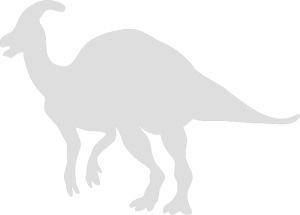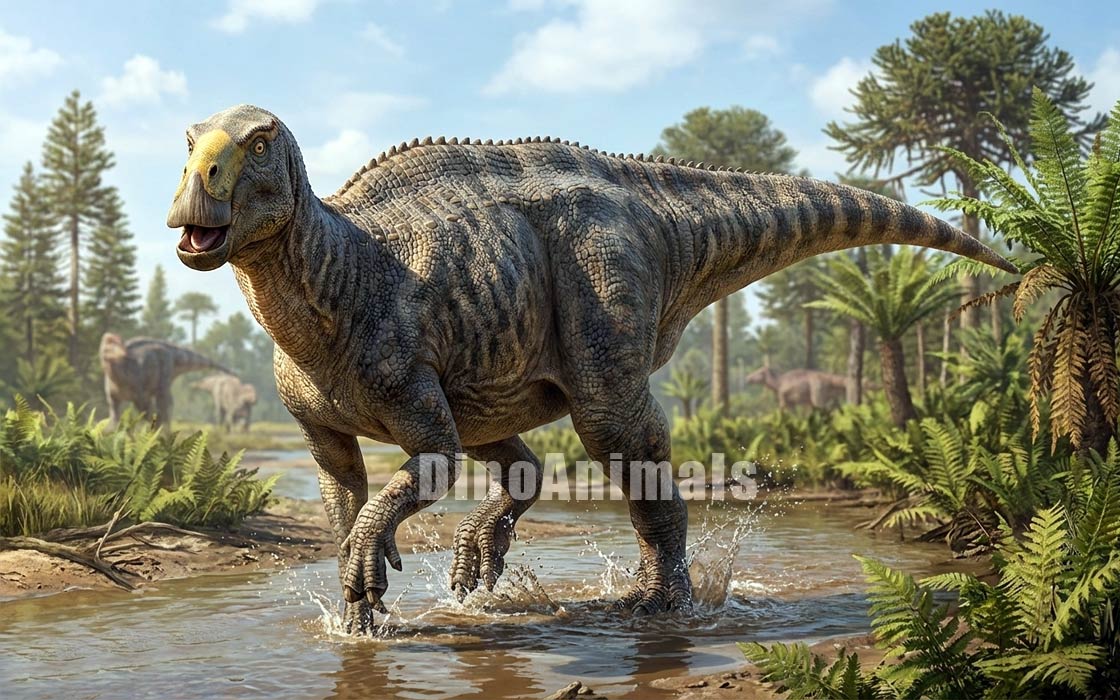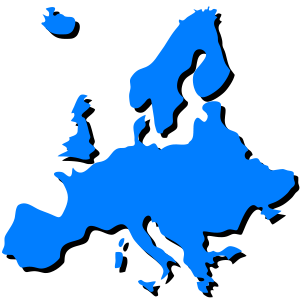Every month, 100,000 readers use the Dinosaur Database, but we receive no support from you. Developing and updating the database requires a lot of work. If you want it to remain open and be updated, please support us via the "Buy us a coffee" button available on every page or via the Support page.
Dinosaur: Cariocecus bocagei

| Length*: | 5.1 m | 16.7 ft |
| Weight*: | 600 kg | 1,323 lb |
*The largest known specimen
Description
Cariocecus bocagei
Cariocecus bocagei was a medium-sized basal hadrosauroid ornithopod dinosaur that lived in what is now Portugal during the Early Cretaceous period, approximately 125–121 million years ago (early Barremian stage). It was discovered in the Papo Seco Formation of the Lusitanian Basin, a sedimentary deposit known for its shallow marine and coastal facies preserving diverse vertebrate remains.
The name Cariocecus references the Iberian and Lusitanian war deity syncretized with Mars and Ares, alluding to the skull’s resemblance to those of ritually sacrificed goats and horses. The species name bocagei honors Portuguese naturalist José Vicente Barbosa du Bocage for his contributions to zoology and paleontology.
As a member of Hadrosauroidea within Iguanodontia, Cariocecus represents an early-diverging form closely related to British taxa, highlighting transatlantic connections in ornithopod evolution.
Etymology
The genus name “Cariocecus” derives from the ancient Iberian war god Cariocecus, syncretized with Roman Mars and Greek Ares, evoking the skull’s superficial similarity to those of goats and horses sacrificed in his honor. The species name “bocagei” commemorates José Vicente Barbosa du Bocage, a pioneering Portuguese naturalist whose work advanced the study of Portuguese fauna and fossils.
Physical Characteristics
Cariocecus bocagei was a medium-sized iguanodontian, estimated to reach 5–7 m (16–23 ft) in length based on skull proportions compared to relatives like Brighstoneus and Comptonatus. The holotype skull base measures 42.3 cm (16.7 in) long, with unfused sutures indicating a juvenile or subadult individual.
Key anatomical features include:
- Partial articulated skull preserving parts of both premaxillae, nasals, frontals, and nearly complete basicranium.
- Right maxilla with 12 erupted teeth, featuring a straight occlusal margin and prominent buccal emargination.
- Right jugal, ectopterygoid, lacrimal, prefrontal, supraorbital, and postorbital bones, showing a robust infratemporal fenestra.
- Low, arched nasal with a midline ridge and prefrontal contacting the nasal, forming a preorbital fossa.
- Robust quadrate and pterygoid, with the latter contributing to a broad palate.
- Unfused sutures across most cranial elements, suggesting immaturity.
These traits indicate a beak-like feeding apparatus typical of basal hadrosauroids, adapted for cropping vegetation.
Diet and Feeding Habits
As a herbivorous ornithopod, Cariocecus bocagei fed on a variety of plants in its coastal ecosystem. Its diet likely included:
- Ferns and cycads, abundant in Early Cretaceous floodplains.
- Conifers and ginkgoes, dominant trees of the period.
- Early angiosperms, emerging in Barremian environments.
Like other iguanodontians, it used a dental battery precursor for grinding tough plant matter, browsing at low to mid heights with its flexible neck.
Habitat and Distribution
Cariocecus bocagei lived in what is now the Setúbal Peninsula, Portugal, specifically in the Papo Seco Formation of the Lusitanian Basin, a geologic unit with shallow marine limestones and coastal sands.
Its environment was characterized by:
- Shallow coastal lagoons and beaches, with tidal influences and marine incursions.
- Humid subtropical climate, supporting lush vegetation and diverse fauna.
- Associated fossils including crocodyliforms, turtles, fish, and other ornithopods.
The Papo Seco Formation yields fragmentary iguanodontians, but Cariocecus provides the first complete skull from Portugal.
Paleoenvironment
The site was a dynamic coastal setting during the Barremian, with warm, humid conditions fostering a mix of terrestrial and marine life. The assemblage includes indeterminate styracosternans, crocodyliforms, and marine reptiles, indicating a productive nearshore habitat.
Behavior and Social Structure
No direct evidence of social behavior exists for Cariocecus bocagei, but iguanodontians often formed herds for protection. Possible behaviors include:
- Gregarious feeding in coastal vegetation patches.
- Facultative bipedality for browsing, shifting to quadrupedality for locomotion.
- Vocalizations or displays using the skull’s robust structure.
As a basal hadrosauroid, it likely occupied mid-sized herbivore niches in a predator-rich environment.
Discovery and Research
The holotype of Cariocecus bocagei was discovered in 2016 by Pedro Marrecas in a limestone outcrop of the Papo Seco Formation, 200 m (660 ft) from Praia do Areia do Mastro, Sesimbra Municipality, Portugal. Prepared in 2024 and µCT-scanned at the Royal Belgian Institute of Natural Sciences, it is accessioned as SHN.832 at the Sociedade de História Natural in Torres Vedras.
This find marks the first iguanodontian skull from Portugal, enhancing understanding of European hadrosauroid diversity.
Discovery Context
Unearthed during fieldwork, the partial skull was articulated and well-preserved despite marine influences. The site, dating to ~130–125 million years ago, is part of the Lusitanian Basin’s Barremian sequence, with additional ornithopod fragments noted nearby.
Significance and Interesting Facts
- First Portuguese iguanodontian with a preserved skull, following postcranial-only taxa like Draconyx, Eousdryosaurus, and Hesperonyx.
- Sister taxon to Brighstoneus and Comptonatus, suggesting dispersal across the proto-Atlantic.
- Juvenile features (unfused sutures) indicate rapid growth in early hadrosauroids.
- Preserves 12 maxillary teeth, aiding studies of dental evolution in Hadrosauroidea.
- Highlights Iberia’s role in Early Cretaceous ornithopod radiation.
Conclusion
Cariocecus bocagei was a medium-sized basal hadrosauroid from the Early Cretaceous of Portugal, exemplifying the early diversification of duck-billed relatives in Europe. Its well-preserved skull reveals immature traits and close ties to British forms, underscoring faunal exchanges. This 2025 discovery bolsters knowledge of iguanodontian evolution in the Lusitanian Basin.
Locations
Sources
Material: Partial premaxillae, nasals, frontals, basicranium, right maxilla with 12 erupted teeth, jugal, ectopterygoid, lacrimal, prefrontal, supraorbital, postorbital
References: Bertozzo, Filippo; Camilo, Bruno; Araújo, Ricardo; Manucci, Fabio; Kullberg, José Carlos; Cerio, Donald G.; Carvalho, Victor Feijó de; Marrecas, Pedro; Figueiredo, Silvério D.; Godefroit, Pascal (2025-09-15). "Cariocecus bocagei, a new basal hadrosauroid from the Lower Cretaceous of Portugal"




